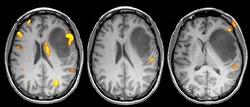MRI Contrast Agent Dye
Gadolinium-based MRI contrast agent dyes, such as Omniscan and Magnevist, are used in magnetic resonance imaging to make certain tissues, abnormalities or disease processes more clearly visible on scans. Recently, the FDA warned that gadolinium deposits could be retained in the body weeks or even months after an MRI. Gadolinium lawsuit plaintiffs claim that these deposits can lead to chronic symptoms associated with gadolinium toxicity and Gadolinium Deposition Disease.
What are Gadolinium MRI Contrast Dyes?
The U.S. Food & Drug Administration (FDA) has approved a number of gadolinium-based MRI agents for use in this country, including:

- Dotarem (Gadoterate meglumine)
- Eovist (Gadoxetate disodium)
- Gadavist (Gadobutrol)
- Magnevist (Gadopentetate Dimeglumine)
- Multihance (Gadobenate Dimeglumine)
- Omniscan (Gadodiamide)
- Optimark (Gadoversetamide)
- Prohance (Gadoteridol)
It is estimated that gadolinium contrast dyes are used in 30% of all MRIs, making these the most-commonly used agents in these procedures.
Complications Associated Gadolinium MRI Contrast Agent Dye
Gadolinium contrast agents are administered intravenously into a vein in the arm. Patients should inform their doctors of the following before undergoing an imaging scan that involves any type of contrast agent:
- Allergies to contrast materials, food, drugs, dyes, preservatives, or animals
- Medications they are taking, including herbal supplements
- Recent illnesses, medical conditions or surgeries
- History of asthma and hay fever
- History of heart disease, diabetes, kidney problems, thyroid disease or sickle cell anemia
Some patients have noted a cold sensation in their arm during administration of gadolinium dyes, and there have also been reports of mild nausea. Headache, vomiting, and dizziness occur in about 1-to-5% of cases.
Certain individuals may experience allergic reactions to gadolinium MRI contrast dyes. These serious anaphylactic reactions are thought to occur in about 1 out of every 10,000 patients. Potential risk factors for an allergic response include a history of asthma and significant reaction to previously administered contrast materials. Patients at risk for such a reaction may be treated with antihistamines and corticosteroid prior to their MRI.
Gadolinium Contrast Dyes and NSF
Gadolinium-based MRI agents are eliminated mainly through the kidneys. As such, individuals with reduced renal function or chronic or acute kidney failure should not be exposed to gadolinium-based MRI agents.
These patients may be at an increased risk for nephrogenic systemic fibrosis (NSF), a debilitating disease that causes localized skin thickening and tightening, as well as damage to internal organs. The FDA first informed the public about the association between gadolinium dyes and NSF in 2006. In 2007, the agency required the addition of a boxed warning regarding the risk of NSF be included on the labeling for all gadolinium-based contrast agents.
FDA Gadolinium Retention Warnings
In July 2015, the FDA announced that it was investigating the risk of brain deposits following repeated use of gadolinium-based MRI contrast agent dyes. The FDA acted after a number of studies reported gadolinium deposits in the brains of patients who had undergone four or more such MRIs.
In December 2017, the FDA issued a new class warning for gadolinium-based MRI contrast agents regarding the potential for gadolinium deposits to be retained in a patient’s body, including the brain, weeks or months after an MRI.
Among other things, the agency indicated that it was requiring the manufacturers of gadolinium contrast dies to issue new Medication Guides to be given to patients the first time they undergo an MRI with a gadolinium agent. The FDA approved those guides in May 2018.
The FDA also ordered the manufacturers of gadolinium-based MRI contrast dyes to conduct human and animal studies to further assess the safety of these drugs.
Lawsuits Link MRI Contrast Agent Dyes to Gadolinium Toxicity, Gadolinium Deposition Disease
A growing number of patients have filed MRI contrast dye lawsuits after developing symptoms allegedly related to the retention of gadolinium deposits.
These symptoms, which the lawsuit characterize as Gadolinium Deposition Disease or gadolinium toxicity, include:
- Persistent headaches
- “Brain fog” and memory problems
- Severe bone and joint pain
- Skin thickening or discoloration
- Burning pain (pins and needles) in arms, legs and/or torso
- Inside Radiology (2013) “Gadolinium Contrast Medium (MRI Contrast agents)” http://www.insideradiology.com.au/pages/view.php?T_id=38#.VhZ18St1yUQ
- Radiology Info (2013) “Contrast Materials” http://www.radiologyinfo.org/en/info.cfm?pg=safety-contrast
- FDA (2010) “FDA Drug Safety Communication: New warnings for using gadolinium-based contrast agents in patients with kidney dysfunction” http://www.fda.gov/Drugs/DrugSafety/ucm223966.htm#aihp
- FDA (July 2015) “FDA Drug Safety Communication: FDA evaluating the risk of brain deposits with repeated use of gadolinium-based contrast agents for magnetic resonance imaging (MRI)” http://www.fda.gov/Drugs/DrugSafety/ucm455386.htm
- FDA (December 2018) “FDA Drug Safety Communication: FDA warns that gadolinium-based contrast agents (GBCAs) are retained in the body; requires new class warnings” https://www.fda.gov/Drugs/DrugSafety/ucm589213.htm
Get the latest news and litigation updates about this case by following us on Facebook. Click the "Like" button below.
Follow Us


